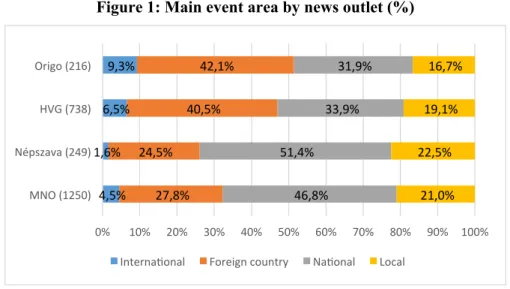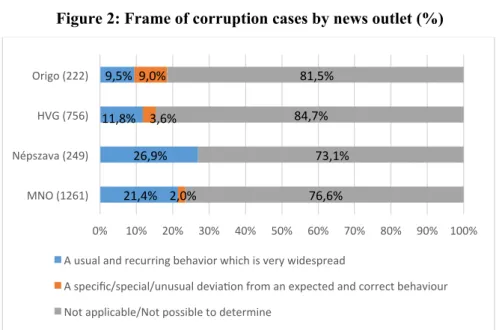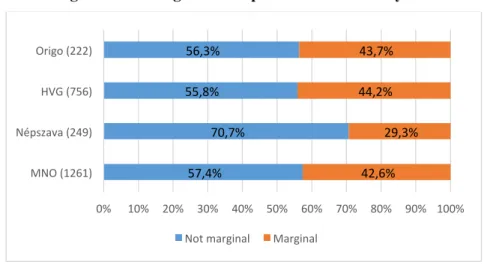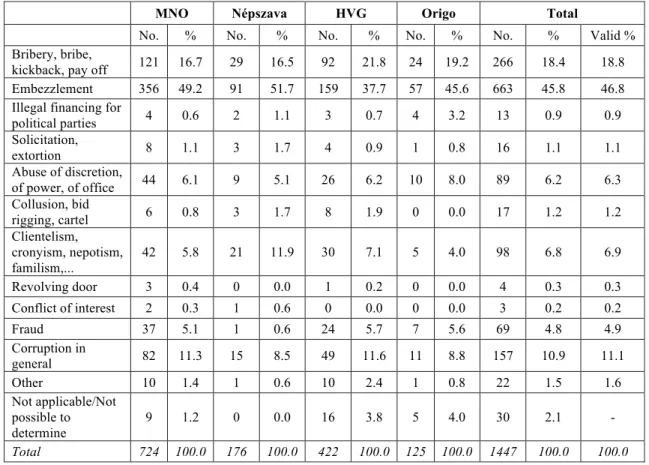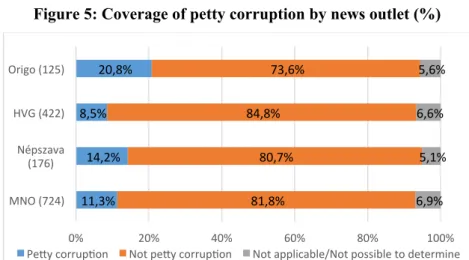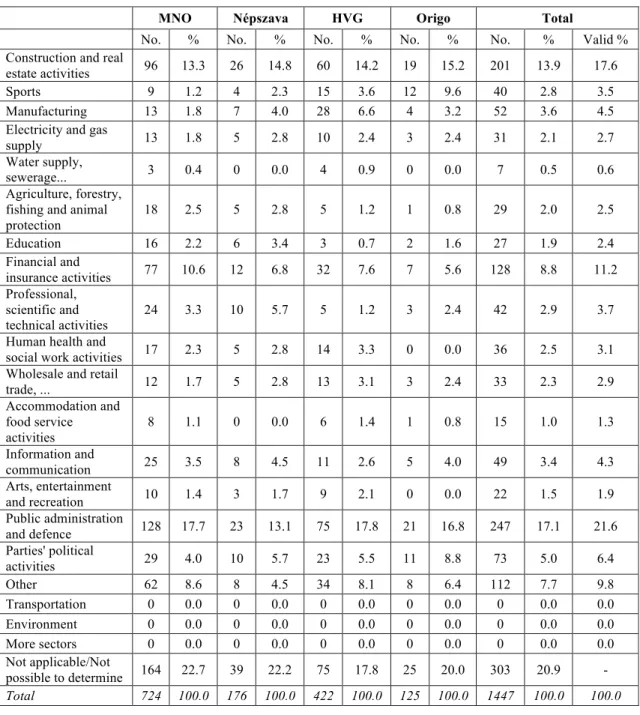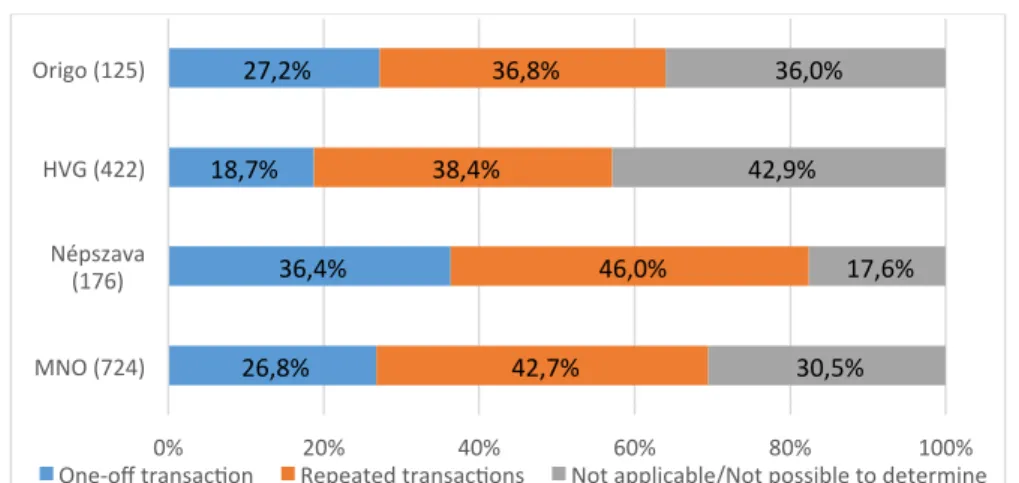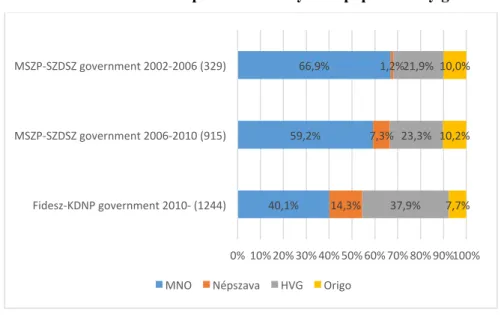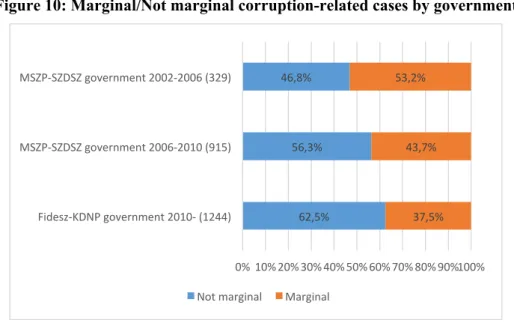EU Grant Agreement number: 290529 Project acronym: ANTICORRP
Project title: Anti-Corruption Policies Revisited
Work Package: WP 6 Media and corruption
Title of deliverable: D 6.1 Extensive content analysis study on the coverage of stories on corruption
Human Assisted Content Analysis of the print press coverage of corruption in Hungary
Due date of deliverable: 30 June, 2016 Actual submission date: 30 June, 2016
Authors: Hajdu Miklós, Pápay Boróka, Szántó Zoltán, Tóth István János (BCE)
Contributors: Tamás Bartus, Ágnes Czakó, Zsuzsa Elekes, Rita Hegedűs, Ferenc Moksony, Ágnes Pogány, Antal Szántay, Lilla Vicsek
Organization name of lead beneficiary for this deliverable: UNIPG, UNIVERSITÀDEGLI STUDI DI PERUGIA
The information and views set out in this publication are those of the author(s) only and do not reflect any collective opinion of the ANTICORRP consortium, nor do they reflect the official opinion of the European Commission. Neither the European Commission nor any person acting on behalf of the European Commission is responsible for the use which might be made of the following information.
Project co-funded by the European Commission within the Seventh Framework Programme Dissemination level
PU Public X
PP Restricted to other programme participants (including the Commission Services) RE Restricted to a group specified by the consortium (including the Commission Services) Co Confidential, only for members of the consortium (including the Commission Services)
CONTENTS
1. Differences among news outlets p. 3
2. Variation over time p. 10
3. National specificities p. 15
Appendix p. 18
Human Assisted Content Analysis of the news media coverage of corruption in Hungary
1. Differences among news outlets
Coverage of corruption in the Hungarian media was analysed for four online news portals, Magyar Nemzet Online (short name: MNO, web: mno.hu), Népszava (web: nepszava.hu) and Heti Világgazdaság (web: hvg.hu) and Origo (web: origo.hu). The first three have both online and printed versions. MNO is considered a centre-right elite/general portal, HVG may be considered a center-left, economics-focused newspaper, while Népszava is a centre-left elite/general medium. Origo does not have a precise political affiliation; it is considered here a neutral, tabloid-like portal due to its variety of entertainment-focused content, but it has a more professional journalistic style than most tabloids, especially in the case of political (domestic and international) articles. In the following section we describe the news portals separately, but refer to the typologies by political affiliation and by media typology (see: Table 1).
Table 1: Political affiliation and media typology of news outlets
Political affiliation
Centre-left Centre-right Neutral
Media typology
Quality newspaper Népszava MNO
Business newspaper HVG
Tabloid Origo
There are significant differences between the main event areas of the articles published in the analysed Hungarian newspapers (see: Figure 11). Regarding the types of news outlets, the elite/general
1All of the articles that were analysed were collected based on the keywords used in Figure 1, Figure 2 and Figure 3.
newspapers Népszava and MNO stand out because of the relatively high proportion of articles they published based on the domestic event area. The proportion of such articles was highest for Népszava.
In contrast, about half of the articles of Origo and HVG (a tabloid and a business weekly newspaper) dealt with international or foreign (non-Hungarian) events. The professional style of the political reporting of Origo and the special attention paid to the neighbouring countries because of the Hungarian minorities living there may explain this phenomenon.
Figure 1: Main event area by news outlet (%)
Pinpointing the frame of the corruption cases was not applicable, or impossible to determine for the majority of the articles in all observed newspapers (see: Figure 2). The reason for this is that not only articles that dealt with corruption cases were analysed. However, elite/general newspapers framed corruption cases as widespread, usual and recurrent behaviour more often than the other news outlets.
In addition, Népszava again stands out from the other publications as more than a quarter of its articles used this frame (i.e. corruption is widespread, typical and recurrent) when reporting on case of corruption.
4,5%
1,6%
6,5%
9,3%
27,8%
24,5%
40,5%
42,1%
46,8%
51,4%
33,9%
31,9%
21,0%
22,5%
19,1%
16,7%
0% 10% 20% 30% 40% 50% 60% 70% 80% 90% 100%
MNO (1250) Népszava (249) HVG (738) Origo (216)
InternaEonal Foreign country NaEonal Local
Figure 2: Frame of corruption cases by news outlet (%)
Corruption was considered marginal2 in about the 44% of the articles from Origo, HVG and MNO, but Népszava again differs significantly with only 29% of the cases considered only marginal (see: Figure 3). However, even though Népszava was classified as a center-left leaning newspaper, the proportion of such articles remained stable during the change of government in 2010. In the meantime, the proportion of articles in the center-right MNO in which the topic of corruption was considered marginal decreased.
2For instance, articles that assess economic trends can also include some general remarks about the level of corruption.
21,4%
26,9%
11,8%
9,5%
2,0%
3,6%
9,0%
76,6%
73,1%
84,7%
81,5%
0% 10% 20% 30% 40% 50% 60% 70% 80% 90% 100%
MNO (1261) Népszava (249) HVG (756) Origo (222)
A usual and recurring behavior which is very widespread
A specific/special/unusual deviaEon from an expected and correct behaviour Not applicable/Not possible to determine
Figure 3: Marginal/Non-marginal corruption-related cases by news outlet (%)
However, the news outlets under analysis are not significantly different regarding the distribution of the main topics of their articles (see: Figure 43). The articles mostly focus on a single case (or some cases) of corruption. Anticorruption activities are mentioned relatively infrequently.
Figure 4: Main topic of the articles by news outlet (%)
The main type of corruption that was described in the articles was mostly embezzlement4 in all of the newspapers under analysis (see: Table 2). The proportion of these articles was highest in the elite/general newspapers, as about the half of the articles of Népszava (52%) and MNO (49%) described embezzlement. The second most frequently described type of corruption was bribery, bribes, kickback
3Findings of Figure 4, Table 2, Figure 5, Table 3, Figure 6 and Figure 7 are based on the articles in which the corruption was not treated as a marginal topic.
4A potential explanation for this phenomenon is included in the final chapter.
57,4%
70,7%
55,8%
56,3%
42,6%
29,3%
44,2%
43,7%
0% 10% 20% 30% 40% 50% 60% 70% 80% 90% 100%
MNO (1261) Népszava (249) HVG (756) Origo (222)
Not marginal Marginal
85,9%
84,5%
82,0%
84,6%
8,8%
10,9%
9,6%
11,4%
3,2%
2,9%
5,0%
2,4%
2,1%
1,7%
3,4%
1,6%
0% 20% 40% 60% 80% 100%
MNO (715) Népszava (174) HVG (417) Origo (123)
A case (or some cases) of corrupEon The corrupEon as a general phenomenon
AnEcorrupEon, regulaEon law or anEcorrupEon naEonal authoriEes' acEviEes AnEcorrupEon acEviEes by ciEzens, NGO…
or pay offs. The business newspaper HVG and the tabloid Origo described cases of this kind more frequently than elite/general newspapers did.
Table 2: Main type of corruption cases by news outlet
MNO Népszava HVG Origo Total
No. % No. % No. % No. % No. % Valid %
Bribery, bribe,
kickback, pay off 121 16.7 29 16.5 92 21.8 24 19.2 266 18.4 18.8
Embezzlement 356 49.2 91 51.7 159 37.7 57 45.6 663 45.8 46.8
Illegal financing for
political parties 4 0.6 2 1.1 3 0.7 4 3.2 13 0.9 0.9
Solicitation,
extortion 8 1.1 3 1.7 4 0.9 1 0.8 16 1.1 1.1
Abuse of discretion,
of power, of office 44 6.1 9 5.1 26 6.2 10 8.0 89 6.2 6.3
Collusion, bid
rigging, cartel 6 0.8 3 1.7 8 1.9 0 0.0 17 1.2 1.2
Clientelism, cronyism, nepotism, familism,...
42 5.8 21 11.9 30 7.1 5 4.0 98 6.8 6.9
Revolving door 3 0.4 0 0.0 1 0.2 0 0.0 4 0.3 0.3
Conflict of interest 2 0.3 1 0.6 0 0.0 0 0.0 3 0.2 0.2
Fraud 37 5.1 1 0.6 24 5.7 7 5.6 69 4.8 4.9
Corruption in
general 82 11.3 15 8.5 49 11.6 11 8.8 157 10.9 11.1
Other 10 1.4 1 0.6 10 2.4 1 0.8 22 1.5 1.6
Not applicable/Not possible to determine
9 1.2 0 0.0 16 3.8 5 4.0 30 2.1 -
Total 724 100.0 176 100.0 422 100.0 125 100.0 1447 100.0 100.0
Differences between the news outlets were identifiable regarding the proportion of articles that dealt with cases of petty corruption (see: Figure 5). Such articles were described by the tabloid Origo more frequently than the general/elite newspapers (Népszava and MNO). In addition, the proportion of cases described was lowest in the case of the business weekly newspaper HVG. The editors of Origo appear to consider corruption mostly to be a transgression, and they deal with minor cases too.
Figure 5: Coverage of petty corruption by news outlet (%)
The sector in which the covered corruption cases occur differs significantly between the news outlets (see: Table 3). However, the sectors that may be characterized by high corruption risks (Construction and real estate activities; Public administration and defence; Parties’ political activities) are largely included in reports in equal proportions. Only Origo stands out because of its relatively high proportion of articles that deal with parties’ political activities.
11,3%
14,2%
8,5%
20,8%
81,8%
80,7%
84,8%
73,6%
6,9%
5,1%
6,6%
5,6%
0% 20% 40% 60% 80% 100%
MNO (724) Népszava (176) HVG (422) Origo (125)
PeZy corrupEon Not peZy corrupEon Not applicable/Not possible to determine
Table 3: Involved sectors in corruption cases by news outlet
MNO Népszava HVG Origo Total
No. % No. % No. % No. % No. % Valid %
Construction and real
estate activities 96 13.3 26 14.8 60 14.2 19 15.2 201 13.9 17.6
Sports 9 1.2 4 2.3 15 3.6 12 9.6 40 2.8 3.5
Manufacturing 13 1.8 7 4.0 28 6.6 4 3.2 52 3.6 4.5
Electricity and gas
supply 13 1.8 5 2.8 10 2.4 3 2.4 31 2.1 2.7
Water supply,
sewerage... 3 0.4 0 0.0 4 0.9 0 0.0 7 0.5 0.6
Agriculture, forestry, fishing and animal
protection 18 2.5 5 2.8 5 1.2 1 0.8 29 2.0 2.5
Education 16 2.2 6 3.4 3 0.7 2 1.6 27 1.9 2.4
Financial and
insurance activities 77 10.6 12 6.8 32 7.6 7 5.6 128 8.8 11.2
Professional, scientific and
technical activities 24 3.3 10 5.7 5 1.2 3 2.4 42 2.9 3.7
Human health and
social work activities 17 2.3 5 2.8 14 3.3 0 0.0 36 2.5 3.1
Wholesale and retail
trade, ... 12 1.7 5 2.8 13 3.1 3 2.4 33 2.3 2.9
Accommodation and food service activities
8 1.1 0 0.0 6 1.4 1 0.8 15 1.0 1.3
Information and
communication 25 3.5 8 4.5 11 2.6 5 4.0 49 3.4 4.3
Arts, entertainment
and recreation 10 1.4 3 1.7 9 2.1 0 0.0 22 1.5 1.9
Public administration
and defence 128 17.7 23 13.1 75 17.8 21 16.8 247 17.1 21.6
Parties' political
activities 29 4.0 10 5.7 23 5.5 11 8.8 73 5.0 6.4
Other 62 8.6 8 4.5 34 8.1 8 6.4 112 7.7 9.8
Transportation 0 0.0 0 0.0 0 0.0 0 0.0 0 0.0 0.0
Environment 0 0.0 0 0.0 0 0.0 0 0.0 0 0.0 0.0
More sectors 0 0.0 0 0.0 0 0.0 0 0.0 0 0.0 0.0
Not applicable/Not
possible to determine 164 22.7 39 22.2 75 17.8 25 20.0 303 20.9 - Total 724 100.0 176 100.0 422 100.0 125 100.0 1447 100.0 100.0
There are significant differences between the newspapers regarding the agent/client focus (see: Figure 6). Articles from HVG have less of a focus on agents, while articles from Népszava are less focused on clients. However, articles that have a focus on both sides are more likely to be published in these centre-left/liberal newspapers than other ones.
Figure 6: Client/agent focus by news outlet (%)
The type of transaction was mostly identifiable in the articles by Népszava (see: Figure 7).
Figure 7: Type of transaction in the corruption-related cases by news outlet (%)
2. Variation over time
The following section discusses the variations over time using the periods between elections as the unit of analysis. In Hungary there were two elections in the period under examination, creating three periods between elections (MSZP-SZDSZ: 2002-2006, MSZP-SZDSZ: 2006-2010, Fidesz-KDNP:
2010-). During the first two, MSZP and SZDSZ were the governing parties, while Fidesz and KDNP governed in the last one.
The reason why the elections of 2006 are important is that there was a slight shift away from socialist ideas towards liberal ones. Also, there was a critical moment between 2002 and 2006, when Prime
69,5%
73,3%
61,8%
68,8%
6,9%
2,3%
6,6%
7,2%
6,8%
7,4%
9,5%
4,0%
16,9%
17,0%
22,0%
20,0%
0% 20% 40% 60% 80% 100%
MNO (724) Népszava (176) HVG (422) Origo (125)
The agent The client Both Not applicable/Not possible to determine
26,8%
36,4%
18,7%
27,2%
42,7%
46,0%
38,4%
36,8%
30,5%
17,6%
42,9%
36,0%
0% 20% 40% 60% 80% 100%
MNO (724) Népszava (176) HVG (422) Origo (125)
One-off transacEon Repeated transacEons Not applicable/Not possible to determine
Minister Peter Medgyessy resigned in 2004 soon after saying that SZDSZ is “full of corruption”.
Ferenc Gyurcsány was elected Prime Minister by MSZP with the support of the coalition partner SZDSZ.
The PM also changed during the second period of analysis. In 2009 Ferenc Gyurcsány resigned as Prime Minister, stating that he was a hindrance to the economic and social reforms that were needed in Hungary. His successor was Gordon Bajnai, who formed a minority government with the external support of SZDSZ.
In the 2010 parliamentary elections, the Fidesz-KDNP alliance won the outright majority of MP seats.
MSZP suffered heavy losses and SZDSZ was unable to enter the legislature. Before the elections there were major corruption scandals that could also have contributed to the defeat of MSZP and SZDSZ. A conservative government was formed after four socialist-liberal cabinets.
As Figure 85 demonstrates, the centre-right reported on corruption more frequently (67% of the total number of articles) during the MSZP-SZDSZ government between 2002 and 2006, and less frequently (40%) during the Fidesz-KDNP government. Centre-left news outlets reported significantly more during the Fidesz-KDNP government, while the amount of articles published by Origo remained stable.
We can conclude that the amount of articles published between elections clearly demonstrates the political affiliation of the newspapers with the governing party through the prevalence of negative reports.
In addition, the number of articles about corruption continuously increased during the different periods, indicating the increasing attention of the press to this topic.
5All of the articles that were analysed were collected based on the keywords used in Figure 8, Figure 9 and Figure 10.
Figure 8: Distribution of corruption articles by newspaper and by government
In most cases it was not possible to determine whether corruption was being framed as a typical, recurring form of behaviour, or as specific deviation from an expected behaviour (see: Figure 9).
However, during the MSZP-SZDSZ government (2006-2010) the representation of corruption as a general behaviour increased to 22% among the articles under analysis. It should be mentioned here that the proportion of articles dealing with cases of corruption remained constantly about 85% in each period.
Figure 9: Framing of corruption cases by government
40,1%
59,2%
66,9%
14,3%
7,3%
1,2%
37,9%
23,3%
21,9%
7,7%
10,2%
10,0%
0% 10% 20% 30% 40% 50% 60% 70% 80% 90% 100%
Fidesz-KDNP government 2010- (1244) MSZP-SZDSZ government 2006-2010 (915) MSZP-SZDSZ government 2002-2006 (329)
MNO Népszava HVG Origo
15,3%
21,7%
17,6%
3,3%
2,3%
3,0%
81,4%
76,0%
79,3%
0% 10% 20% 30% 40% 50% 60% 70% 80% 90% 100%
Fidesz-KDNP government 2010- (1244) MSZP-SZDSZ government 2006-2010 (915) MSZP-SZDSZ government 2002-2006 (329)
A usual and recurring behaviour which is very widespread
A specific/special/unusual deviaEon from an expected and correct behaviour Not applicable/Not possible to determine
Corruption-related content in the articles become less marginal over time (see: Figure 10). During the MSZP-SZDSZ government (2002-2006), 53% of corruption-related articles framed corruption cases as marginal, while under the Fidesz-KDNP government the proportion dropped to 38%. In the case of non-marginal corruption, in more than 80% of articles specific corruption cases were mentioned, and only 10% of the articles described corruption as a general phenomenon, while the rest of the articles referred to anticorruption regulation and activities by both NGO’s and governmental organizations.
There were no significant changes over time from this perspective.
Figure 10: Marginal/Not marginal corruption-related cases by government
The type of corruption described by the examined news outlets remained approximately stable over time (see: Table 46). The amount of reported embezzlement increased to 47% during the Fidesz-KDNP government, while the number of fraud-related articles dropped from seven to four percent.
6Findings of Table 4 and Table 5 are based on articles in which corruption was not considered a marginal topic.
62,5%
56,3%
46,8%
37,5%
43,7%
53,2%
0% 10% 20% 30% 40% 50% 60% 70% 80% 90% 100%
Fidesz-KDNP government 2010- (1244) MSZP-SZDSZ government 2006-2010 (915) MSZP-SZDSZ government 2002-2006 (329)
Not marginal Marginal
Table 4: Types of corruption cases by government
MSZP-SZDSZ government
2002-2006
MSZP-SZDSZ government
2006-2010
Fidesz-KDNP government
2010-
Total
No. % No. % No. % No. % Valid %
Bribery, bribe, kickback,
pay off 27 17.5 89 17.3 150 19.3 266 18.4 18.8
Embezzlement 66 42.9 230 44.7 367 47.2 663 45.8 46.8
Illegal financing for
political parties 0 0.0 8 1.6 5 0.6 13 0.9 0.9
Solicitation, extortion 3 1.9 7 1.4 6 0.8 16 1.1 1.1
Abuse of discretion, of
power, of office 11 7.1 27 5.2 51 6.6 89 6.2 6.3
Collusion, bid rigging,
cartel 2 1.3 11 2.1 4 0.5 17 1.2 1.2
Clientelism, cronyism,
nepotism, familism,... 11 7.1 34 6.6 53 6.8 98 6.8 6.9
Revolving door 2 1.3 1 0.2 1 0.1 4 0.3 0.3
Conflict of interest 2 1.3 0 0.0 1 0.1 3 0.2 0.2
Fraud 11 7.1 27 5.2 31 4.0 69 4.8 4.9
Corruption in general 15 9.7 57 11.1 85 10.9 157 10.9 11.1
Other 2 1.3 12 2.3 8 1.0 22 1.5 1.6
Abuse of public resources 0 0.0 0 0.0 0 0.0 0 0.0 0.0
Wrong asset/income
declaration 0 0.0 0 0.0 0 0.0 0 0.0 0.0
Living beyond one's
means 0 0.0 0 0.0 0 0.0 0 0.0 0.0
Not applicable/Not
possible to determine 2 1.3 12 2.3 16 2.1 30 2.1 -
Total 154 100.0 515 100.0 778 100.0 1447 100.0 100.0
The amount of major corruption cases reported on remained stable between the elections at around 82 percent. The amount of articles describing corruption cases as repeated transactions also remained stable over time at around 42%. This means that, considering the examined articles, corruption did not become more institutionalized over time.
During the first MSZP-SZDSZ government, 22 percent of all articles dealt with corruption cases that occurred in the public administration/defence sector, and 23% in the financial sector (see: Table 5).
Both of these numbers decreased over time. The occurrence of construction-related corruption cases remained stable over time (13-15%). The proportion of articles about corruption related to financial and insurance activities decreased by 17 percentage points between the first and last analysed periods, probably because of the drop in interest in the Kulcsár case.
Table 5: Involved sectors in corruption cases by government
MSZP-SZDSZ government
2002-2006
MSZP- SZDSZ government
2006-2010
Fidesz-KDNP government
2010-
Total
No. % No. % No. % No. % Valid %
Construction and real
estate activities 20 13.0 67 13.0 114 14.7 201 13.9 17.6
Sport 5 3.2 13 2.5 22 2.8 40 2.8 3.5
Manufacturing 9 5.8 20 3.9 23 3.0 52 3.6 4.5
Electricity and gas
supply 3 1.9 1 0.2 27 3.5 31 2.1 2.7
Water supply,
sewerage... 2 1.3 4 0.8 1 0.1 7 0.5 0.6
Agriculture, forestry, fishing and animal protection
1 0.6 14 2.7 14 1.8 29 2.0 2.5
Education 1 0.6 10 1.9 16 2.1 27 1.9 2.4
Financial and
insurance activities 35 22.7 43 8.3 50 6.4 128 8.8 11.2
Professional, scientific
and technical activities 3 1.9 10 1.9 29 3.7 42 2.9 3.7
Human health and
social work activities 4 2.6 12 2.3 20 2.6 36 2.5 3.1
Wholesale and retail
trade, ... 3 1.9 15 2.9 15 1.9 33 2.3 2.9
Accommodation and
food service activities 1 0.6 3 0.6 11 1.4 15 1.0 1.3
Information and
communication 6 3.9 14 2.7 29 3.7 49 3.4 4.3
Arts, entertainment
and recreation 1 0.6 3 0.6 18 2.3 22 1.5 1.9
Public administration
and defence 34 22.1 86 16.7 127 16.3 247 17.1 21.6
Parties' political
activities 5 3.2 23 4.5 45 5.8 73 5.0 6.4
Other 5 3.2 47 9.1 60 7.7 112 7.7 9.8
Transportation 0 0.0 0 0.0 0 0.0 0 0.0 0.0
Environment 0 0.0 0 0.0 0 0.0 0 0.0 0.0
More sectors 0 0.0 0 0.0 0 0.0 0 0.0 0.0
Not applicable/Not
possible to determine 16 10.4 130 25.2 157 20.2 303 20.9 -
Total 154 100.0 515 100.0 778 100.0 144
7 100.0 100.0
3. National Specificities
As investigative journalism does not have long tradition in Hungary, the Hungarian news outlets mainly publish simple news articles about cases. Also, news outlets tend to trade information between
each other instead of undertaking deep investigations into corruption. Journalists do not usually write extensive articles about cases but just summarize the most important details in the form of short news reports.
The main type of corruption described in the articles was embezzlement (regarding all the analysed news outlets and for each time period). Embezzlement as type of corruption refers almost in every case to specific cases in the legal sense of the word7. Embezzlement can occur in both the public and the private sector, which may explain why the number of cases of embezzlement is high in relation to corruption-related crimes. Table 6 demonstrates how the proportion of embezzlement from the total number of corruption-related crimes remained at around 25 % between 2006 and 2013.
Table 6: Number of corruption-related crimes between 2006 and 2013
2006 2007 2008 2009 2010 2011 2012 2013
Embezzlement,
misdemeanour 832 726 614 662 659 512 508 467
Embezzlement,
felony 1284 1094 1180 1265 1331 1043 1158 1020
Total (both misdemeanour and felony)
2116
(25.6%) 1820
(23,7%) 1794
(21,5%) 1927
(21,4%) 1990
(21,6%) 1555
(23,2%) 1666
(27,9%) 1487 (24,3%) Total number
of corruption related crimes
8248 (100.0%)
7676 (100,0%)
8354 (100,0%)
8988 (100,0%)
9195 (100,0%)
6697 (100,0%)
5968 (100,0%)
6113 (100,0%)
Source: National Office for the Judiciary
Another potential explanation for this phenomenon is that during the socialist era, the concept of
‘corruption’ was not widely employed; most such cases were described as embezzlement. This path dependency with the use of language may have led to the preservation of the terminology used by journalists.
There are some meaningful differences between the news outlets regarding the proportion of articles that deal with petty or grand corruption cases. Petty corruption is reported on more frequently in the less sophisticated news outlets. The nature of the readership may have determined which cases are described by the news outlets, even regarding their magnitude and political background.
All of the analysed Hungarian news outlets are basically agent-focused, even if there are some differences between them regarding the proportion of agent or client-focused articles. This is probably due to the relatively high number of cases in which the agent was in the key position (e.g. in the case of
7 ‘Embezzlement’ is used to mean when a person unlawfully appropriates or disposes of a thing with which he has been entrusted.
Hagyó). In addition, the reporting style of the Hungarian news outlets may explain the low number of articles which focus on clients, or on both sides of a case.
Finally, concerning the type of original transaction, all of the news outlets which were examined published a high proportion of articles that describe repeated transactions. On the one hand, this may be due to the existence of national and local cases of corruption. On the other hand, it may be due to the rapid news-reporting style of the journalists which inclines them to report about recurring cases of greater importance.
Appendix:
frequency tables for the analysed variables
2. Name of the newspaper
Frequency Percent
MNO 1261 50,7
NOL 249 10,0
HVG 756 30,4
Origo 222 8,9
Total 2488 100,0
4. Type of news article
Frequency Percent
News article 2101 84,4
Editorial, commentary... 175 7,0
Journalistic investigation 32 1,3
Interview 73 2,9
Short text, ... 65 2,6
Letters to editor 7 0,3
Satirical articles 28 1,1
Other 7 0,3
Total 2488 100,0
5. Main event arena
Frequency Percent
International 128 5,1
Foreign country 798 32,1
National 1032 41,5
Local 495 19,9
Not applicable/Not possible to
determine 35 1,4
Total 2488 100,0
5c. EU funds
Frequency Percent
Yes 99 4,0
No/Not applicable/Not possible to
determine 2389 96,0
Total 2488 100,0
7. Frame: Corruption (the case of corruption) is framed as:
Frequency Percent A usual and recurring behavior
which is very widespread 447 18,0
A specific/special/unusual deviation from an expected and
correct behaviour 72 2,9
Not applicable/Not possible to
determine 1969 79,1
Total 2488 100,0
8. Filter question: In the article, the "corruption-related issue" is:
Frequency Percent
Not marginal 1447 58,2
Marginal 1041 41,8
Total 2488 100,0
8b. Other main topic: In the article where the "corruption" is not the central topic, the main topic is:
Frequency Percent Valid Percent
Valid
Politics 487 19,6 46,8
Economy 156 6,3 15,0
Foreign affairs, diplomacy 75 3,0 7,2
Health 9 0,4 0,9
Education 9 0,4 0,9
Judicial, police activities 75 3,0 7,2
Sport 15 0,6 1,4
Environment, energy 7 0,3 0,7
Music, arts, literature, TV
shows, movies 38 1,5 3,7
Welfare, social protection 7 0,3 0,7
Religion 6 0,2 0,6
Agriculture 5 0,2 0,5
Travel (holidays) 9 0,4 0,9
Public administration 34 1,4 3,3
Other 109 4,4 10,5
Total 1041 41,8 100,0
Missing --- 1447 58,2
Total 2488 100,0
9. Main topic: The article is mainly about:
Frequency Percent Valid Percent
Valid
A case (or some cases) of
corruption 1207 48,5 83,4
The corruption as a general
phenomenon 136 5,5 9,4
Anticorruption, regulation law or anticorruption national authorities' activities
52 2,1 3,6
Anticorruption activities by
citizens, NGO.... 34 1,4 2,3
Other 16 0,6 1,1
Not applicable/Not possible
to determine 2 0,1 0,1
Total 1447 58,2 100,0
Missing --- 1041 41,8
Total 2488 100,0
11. News article impetus
Frequency Percent Valid Percent
Valid
Publication of phone tapping
or similar 20 0,8 1,4
Judicial activities 773 31,1 53,4
End of imprisonment for a
person judged for corruption 6 0,2 0,4
Statement/interview 160 6,4 11,1
Publication of
data/studies/reports about corruption
66 2,7 4,6
Journalistic investigation 102 4,1 7,0
Anti-corruption law 28 1,1 1,9
Anticorruption agencies’
activities 24 1,0 1,7
Other 244 9,8 16,9
Not applicable/Not possible
to determine 24 1,0 1,7
Total 1447 58,2 100,0
Missing --- 1041 41,8
Total 2488 100,0
11b. If the article impetus is a statement/interview, who gives the statement/interview?
Frequency Percent Valid Percent
Valid
A political figure 109 4,4 68,1
Another figure 51 2,0 31,9
Total 160 6,4 100,0
Missing --- 2328 93,6
Total 2488 100,0
12. Main type of corruption
Frequency Percent Valid Percent
Valid
Bribery, bribe, kickback, pay
off 266 10,7 18,4
Embezzlement 663 26,6 45,8
Illegal financing to political
parties 13 0,5 0,9
Solicitation, extortion 16 0,6 1,1
Abuse of discretion, of
power, of office 89 3,6 6,2
Collusion, bid rigging, cartel 17 0,7 1,2
Clientelism, cronyism,
nepotism, familism,... 98 3,9 6,8
Revolving door 4 0,2 0,3
Conflict of interest 3 0,1 0,2
Fraud 69 2,8 4,8
Corruption in general 157 6,3 10,9
Other 22 0,9 1,5
Not applicable/Not possible
to determine 30 1,2 2,1
Total 1447 58,2 100,0
Missing --- 1041 41,8
Total 2488 100,0
13. Petty corruption
Frequency Percent Valid Percent
Valid
Yes 169 6,8 11,7
No/Not applicable/Not
possible to determine 1278 51,4 88,3
Total 1447 58,2 100,0
Missing --- 1041 41,8
Total 2488 100,0
14. Sector
Frequency Percent Valid Percent
Valid
Construction and real estate
activities 201 8,1 13,9
Sport 40 1,6 2,8
Manufacturing 52 2,1 3,6
Electricity and gas supply 31 1,2 2,1
Water supply, sewerage... 7 ,3 ,5
Agriculture, forestry, fishing
and animal protection 29 1,2 2,0
Education 27 1,1 1,9
Financial and insurance
activities 128 5,1 8,8
Professional, scientific and
technical activities 42 1,7 2,9
Human health and social
work activities 36 1,4 2,5
Wholesale and retail trade,
... 33 1,3 2,3
Accomodation and food
service activities 15 ,6 1,0
Information and
communication 49 2,0 3,4
Arts, entertainment and
recreation 22 ,9 1,5
Public administration and
defence 247 9,9 17,1
Parties' political activities 73 2,9 5,0
Other 112 4,5 7,7
Not applicable/Not possible
to determine 303 12,2 20,9
Total 1447 58,2 100,0
Missing --- 1041 41,8
Total 2488 100,0
15. Client/agent focus: The article is focused on:
Frequency Percent Valid Percent
Valid
The agent 979 39,3 67,7
The client 91 3,7 6,3
Both 107 4,3 7,4
Not applicable/Not possible
to determine 270 10,9 18,7
Total 1447 58,2 100,0
Missing --- 1041 41,8
Total 2488 100,0
16. Type of agent
Frequency Percent Valid Percent
Valid
A single actor or several
actors acting independently 475 19,1 32,8 A group or network of
actors 478 19,2 33,0
An institution, company,
association, political party 195 7,8 13,5 Not applicable/Not possible
to determine 299 12,0 20,7
Total 1447 58,2 100,0
Missing --- 1041 41,8
Total 2488 100,0
17a. Agent1_position
Frequency Percent Valid Percent
Valid
Government or state high
representative 432 17,4 29,9
Public official, manager,
consultant 140 5,6 9,7
Public relation officer, press
officer, spokesman 9 0,4 0,6
Politician 47 1,9 3,2
Mayor, local administrators 152 6,1 10,5
Businessman, CEO, chairman 140 5,6 9,7
Citizen 7 0,3 ,5
Judge, Prosecutor, Inspector,
Detective 25 1,0 1,7
Policeman 42 1,7 2,9
Lawyer, legal adviser 9 0,4 0,6
Journalist, Editor, media man 4 0,2 0,3
Medical doctor, nurse 14 0,6 1,0
Professor, teacher, Principal 16 0,6 1,1
Banker 26 1,0 1,8
Professional lobbyist,
professional P.R. people 2 0,1 0,1
Sport actor 21 0,8 1,5
Trade-unionist 5 0,2 0,3
Religious figure 8 0,3 0,6
Representative of NGO or
civil society 14 0,6 1,0
Member of the organized
crime 1 0,0 0,1
Other 29 1,2 2,0
Not applicable/Not possible to
determine 304 12,2 21,0
Total 1447 58,2 100,0
Missing --- 1041 41,8
Total 2488 100,0
20. Type of client
Frequency Percent Valid Percent
Valid
A single actor or several
actors acting independently 204 8,2 14,1
A group or network of actors 125 5,0 8,6
An institution, company,
association, political party 122 4,9 8,4
Not applicable/Not possible
to determine 996 40,0 68,8
Total 1447 58,2 100,0
Missing --- 1041 41,8
Total 2488 100,0
21a. Client1_position
Frequency Percent Valid Percent
Valid
Government or state high
representative 50 2,0 3,5
Public official, manager,
consultant 20 0,8 1,4
Politician 11 0,4 0,8
Mayor, local
administrators 8 0,3 0,6
Businessman, CEO,
chairman 225 9,0 15,5
Citizen 56 2,3 3,9
Judge, Prosecutor,
Inspector, Detective 3 0,1 0,2
Policeman 7 0,3 0,5
Lawyer, legal adviser 5 0,2 0,3
Journalist, Editor, media
man 5 0,2 0,3
Professor, teacher,
Principal 2 0,1 0,1
Banker 6 0,2 0,4
Professional lobbyist,
professional P.R. people 2 0,1 0,1
Sport actor 6 0,2 0,4
Trade-unionist 1 0,0 0,1
Representative of NGO or
civil society 8 0,3 0,6
Member of the organized
crime 13 0,5 0,9
Other 14 0,6 1,0
Not applicable/Not
possible to determine 1005 40,4 69,5
Total 1447 58,2 100,0
Missing --- 1041 41,8
Total 2488 100,0
24a. Object of exchange1: What does the agent give to the client? What kind of goods does the embezzler appropriates?
Frequency Percent Valid Percent
Valid
Purely material goods 530 21,3 36,6
Not material goods 349 14,0 24,1
Not applicable/Not possible
to determine 568 22,8 39,3
Total 1447 58,2 100,0
Missing --- 1041 41,8
Total 2488 100,0
24b. Object of exchange2: What does the client give to the agent?
Frequency Percent Valid Percent
Valid
Purely material goods 256 10,3 17,7
Not material goods 41 1,6 2,8
Not applicable/Not possible
to determine 1150 46,2 79,5
Total 1447 58,2 100,0
Missing --- 1041 41,8
Total 2488 100,0
25. What was the base/original transaction that was affected by corruption?
Frequency Percent Valid Percent
Valid
Public procurement 144 5,8 10,0
Licences, certifications,
positions 164 6,6 11,3
Access to service that
someone is entitled to 17 0,7 1,2
Inspections, neutralization of negative consequences
of inspections 56 2,3 3,9
Other 266 10,7 18,4
Embezzlement: no original
transaction 68 2,7 4,7
Selling or purchase in
public sector 127 5,1 8,8
Labour contract 17 0,7 1,2
Selling or purchase in
private sector 36 1,4 2,5
Not applicable/Not possible
to determine 552 22,2 38,1
Total 1447 58,2 100,0
Missing --- 1041 41,8
Total 2488 100,0

